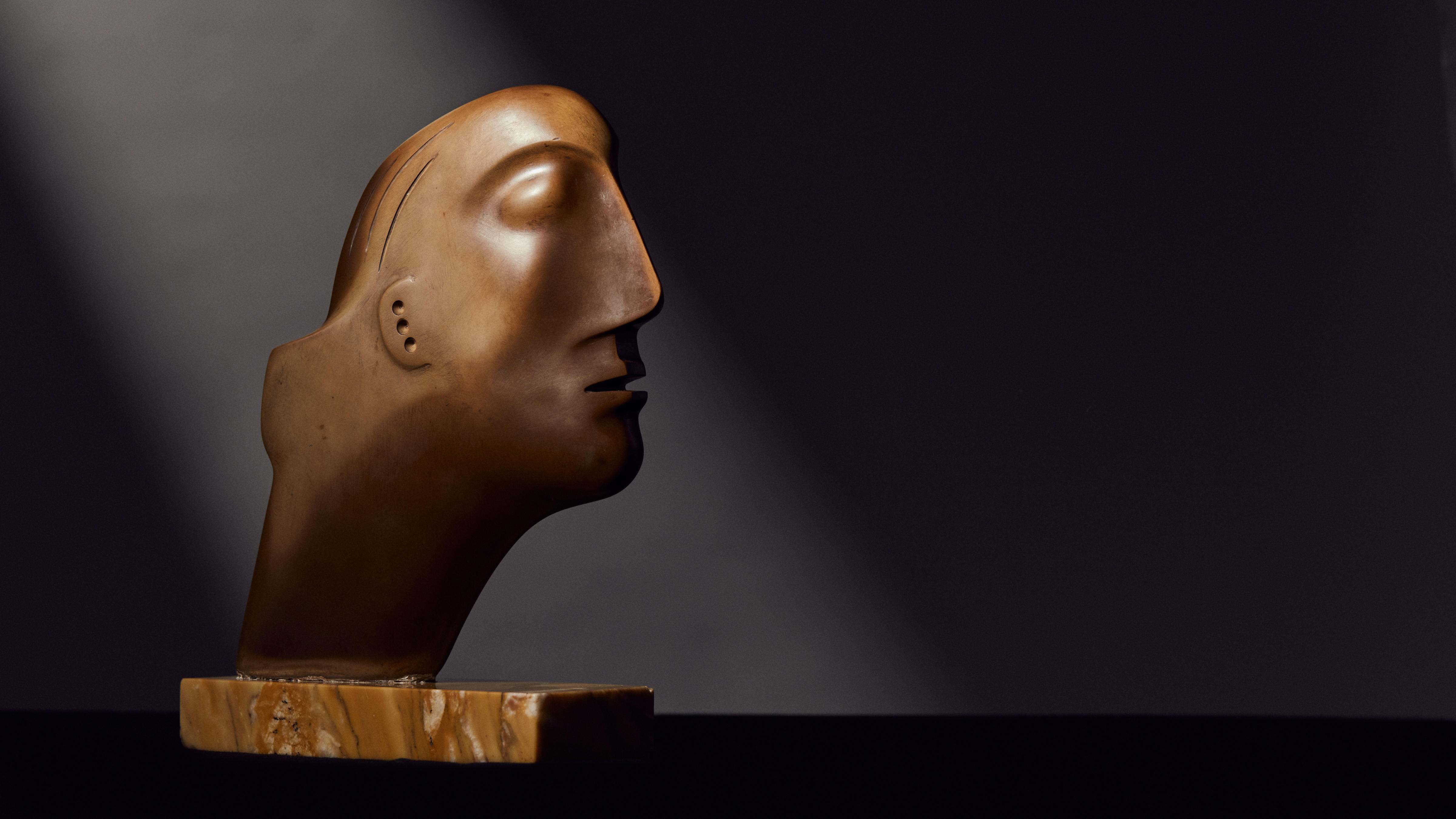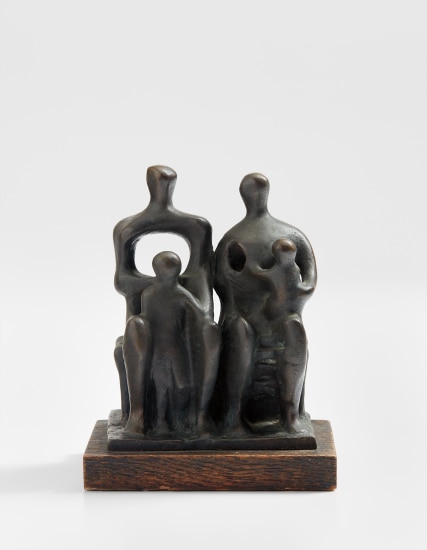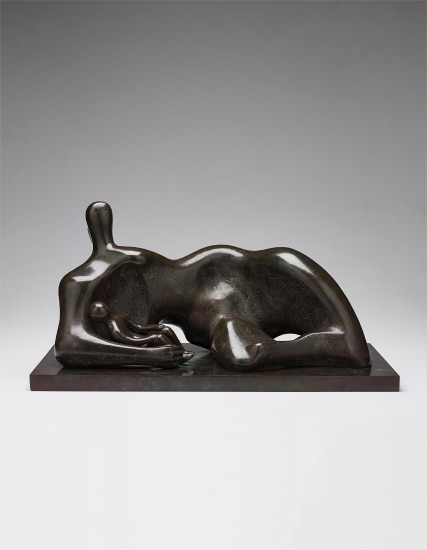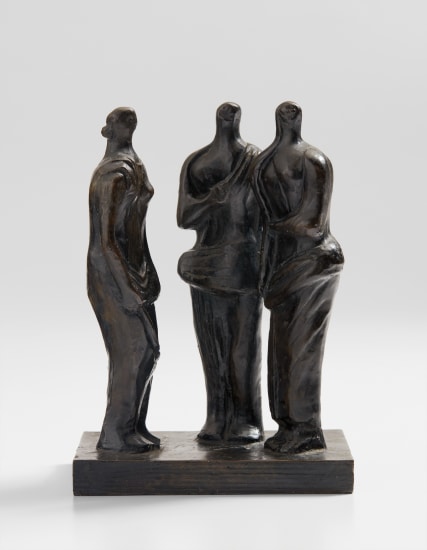Property of a Gentleman, Boston Henry Moore Torso 1966 white marble height 31 in. (78.7 cm) This work is unique.
Provenance Marlborough Fine Art, London Marina & Willy Staehelin-Peyer, Zurich Private Collection Sotheby's, London, Impressionist and Modern Art Day Sale, February 6, 2008, lot 374 Acquired at the above sale by the present owner Exhibited London, Marlborough Fine Art, Henry Moore Carvings 1923-1966, 1967 New York, The Metropolitan Museum of Art, Henry Moore 60 Years of his Art, 1983 Literature Henry Moore Carvings: 1923 - 1966, exh. cat., Marlborough Fine Art, London, 1967, no. 23 (illustrated) R. Melville, Henry Moore Sculpture & Drawings, 1921-1969, London, 1970, no. 702, pp. 30 & 307 (illustrated) A. Bowness (ed.), Henry Moore Complete Sculpture: 1964-73, London, 1977, vol. 4, no. 554, p. 46 & pls. 46 & 47 (illustrated) Henry Moore 60 Years of his Art, exh. cat., The Metropolitan Museum of Art, New York, 1983 (illustrated) Henry Moore Sculptures, Drawings, Graphics, exh. cat., The British Council, London, 1981, no. 392, p. 184 (illustrated) Catalogue Essay Henry Moore’s exemplary sculptures are characterized by his mastery and inherent understanding of his mediums and techniques. Throughout his oeuvre he continued to delve into the abstraction of the human form. Seemingly growing organically from his natural materials, his sculptures are defined by curving lines that bring into dialogue areas of mass and void in a manner that is as elegant as it is imposing. Torso, 1966 rendered in marble shows Moore’s re-evaluation of the subject matter that had first arisen over a decade earlier as a result of Draped Reclining Figure. The present lot is an example of Moore’s most abstract portfolio of sculptures and as such brings to light the core ideas that lie at the heart of his artistic developments. Born out of a distinct Modernist mindset the pieces are indebted to the thoughts propagated by artists such as Pablo Picasso Joan Miro and Alexander Archipenko who tested the boundaries of figurative art through a reductive process. Though the title Torso, certainly aids our understanding of the work’s subject matter, upon closer inspection the identifiable inward curve of a waist becomes evident just as the broadening back suggests the space for emerging shoulders. Equally as important as the form, is the smooth iridescent texture of the marble Moore devotedly polishes here. In this way the surface of his sculpture echoes a tactile sensuousness so intrinsic to the bodily subject he depicts here. Moore explains, “There have been two major influences on my work. The main one, perhaps, is drawing and modelling from the human figure – I have looked at the nude for half my life. Our own bodies, our own make up, have the greatest influence on art.” (Henry Moore in Henry Moore Sculpture, London 1978, p.15) Inspiration for Torso, 1966 was drawn from the extensive process of creating Draped Reclining Figure, 1953. As Moore reveals, “A large work like the Draped Reclining Figure (1953) has to be cast in several pieces which are then welded together. That figure was cast in about five sections – the head, two arms, the torso and the legs. I have to see, of course, the sections in wax before they are cast and when I saw the torso part, separate from the rest, even I, who had done it, was struck by its completeness and impressiveness just as a thing on its own. It was then that I thought of making the part, a work in its own." (Henry Moore quoted in T. Walsh, The Dark Matter of Words: Absence, Unknowing, and Emptiness in Literature, p. 22) Read More
Property of a Gentleman, Boston Henry Moore Torso 1966 white marble height 31 in. (78.7 cm) This work is unique.
Provenance Marlborough Fine Art, London Marina & Willy Staehelin-Peyer, Zurich Private Collection Sotheby's, London, Impressionist and Modern Art Day Sale, February 6, 2008, lot 374 Acquired at the above sale by the present owner Exhibited London, Marlborough Fine Art, Henry Moore Carvings 1923-1966, 1967 New York, The Metropolitan Museum of Art, Henry Moore 60 Years of his Art, 1983 Literature Henry Moore Carvings: 1923 - 1966, exh. cat., Marlborough Fine Art, London, 1967, no. 23 (illustrated) R. Melville, Henry Moore Sculpture & Drawings, 1921-1969, London, 1970, no. 702, pp. 30 & 307 (illustrated) A. Bowness (ed.), Henry Moore Complete Sculpture: 1964-73, London, 1977, vol. 4, no. 554, p. 46 & pls. 46 & 47 (illustrated) Henry Moore 60 Years of his Art, exh. cat., The Metropolitan Museum of Art, New York, 1983 (illustrated) Henry Moore Sculptures, Drawings, Graphics, exh. cat., The British Council, London, 1981, no. 392, p. 184 (illustrated) Catalogue Essay Henry Moore’s exemplary sculptures are characterized by his mastery and inherent understanding of his mediums and techniques. Throughout his oeuvre he continued to delve into the abstraction of the human form. Seemingly growing organically from his natural materials, his sculptures are defined by curving lines that bring into dialogue areas of mass and void in a manner that is as elegant as it is imposing. Torso, 1966 rendered in marble shows Moore’s re-evaluation of the subject matter that had first arisen over a decade earlier as a result of Draped Reclining Figure. The present lot is an example of Moore’s most abstract portfolio of sculptures and as such brings to light the core ideas that lie at the heart of his artistic developments. Born out of a distinct Modernist mindset the pieces are indebted to the thoughts propagated by artists such as Pablo Picasso Joan Miro and Alexander Archipenko who tested the boundaries of figurative art through a reductive process. Though the title Torso, certainly aids our understanding of the work’s subject matter, upon closer inspection the identifiable inward curve of a waist becomes evident just as the broadening back suggests the space for emerging shoulders. Equally as important as the form, is the smooth iridescent texture of the marble Moore devotedly polishes here. In this way the surface of his sculpture echoes a tactile sensuousness so intrinsic to the bodily subject he depicts here. Moore explains, “There have been two major influences on my work. The main one, perhaps, is drawing and modelling from the human figure – I have looked at the nude for half my life. Our own bodies, our own make up, have the greatest influence on art.” (Henry Moore in Henry Moore Sculpture, London 1978, p.15) Inspiration for Torso, 1966 was drawn from the extensive process of creating Draped Reclining Figure, 1953. As Moore reveals, “A large work like the Draped Reclining Figure (1953) has to be cast in several pieces which are then welded together. That figure was cast in about five sections – the head, two arms, the torso and the legs. I have to see, of course, the sections in wax before they are cast and when I saw the torso part, separate from the rest, even I, who had done it, was struck by its completeness and impressiveness just as a thing on its own. It was then that I thought of making the part, a work in its own." (Henry Moore quoted in T. Walsh, The Dark Matter of Words: Absence, Unknowing, and Emptiness in Literature, p. 22) Read More
.jpg)


.jpg)


.jpg)
.jpg)







Testen Sie LotSearch und seine Premium-Features 7 Tage - ohne Kosten!
Lassen Sie sich automatisch über neue Objekte in kommenden Auktionen benachrichtigen.
Suchauftrag anlegen